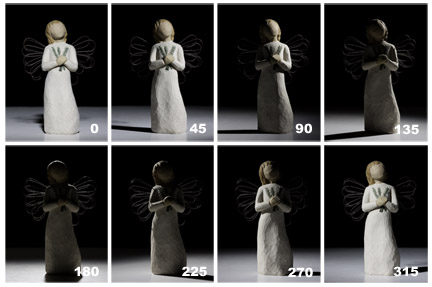One of the continuing themes I will blog about is the variety of techniques to control light using strobes/flashes. These techniques typically originate from The Strobist but other sources are occasionally used in order to expanded and further define a topic.
The angle of the light is first method to control light. The importance of the angle of the light is that it helps define the emotion, shape and details of your subject. In order to define these qualities you need to create interesting shadows. In order to create interesting shadows you can understand the angle of your light.
In the below series of eight photographs, I changed the light angle of each photograph by 45 degrees in order to change the emotion, shape and details of the subject. First, I obtained the proper exposure by placing flash approximately three feet away, two feet above and at zero degrees from the angel. The flash was moved 45 degrees to the right, keeping the same distance, height and exposure until I completed the circle. Notice how the emotion, shape and details of the angel are changed and enhanced by only changing the angle of the light?

Two observations, the first is about the shadow, shape and detail. When the angle of light is from the side (45,90,270 and 315) the shape and detail of the angel’s gown is pronounced. The second observation is when the light is behind the angel it appears brighter (135,180 and 225). This phenomenon, called rim light, occurs because, appears to glance of the subject instead of being absorbed. As you can see rim light helps separate the subject from the background but sometimes must be toned down.
While there are uses for leaving your flash on camera, fill flash is an example, most times your photography will improve when you move your flash off camera.

